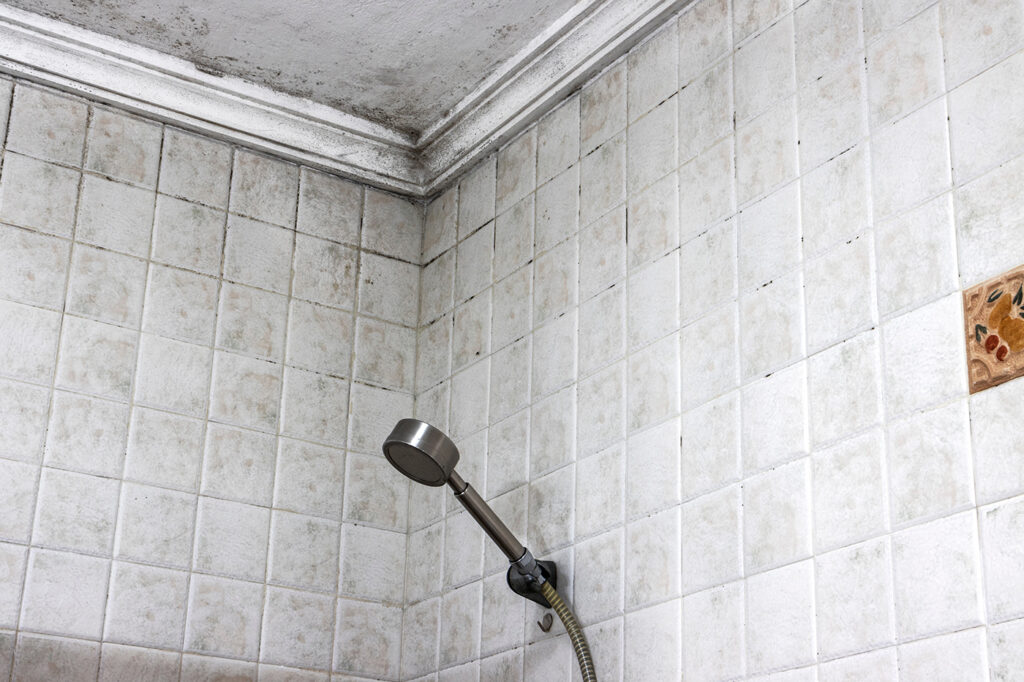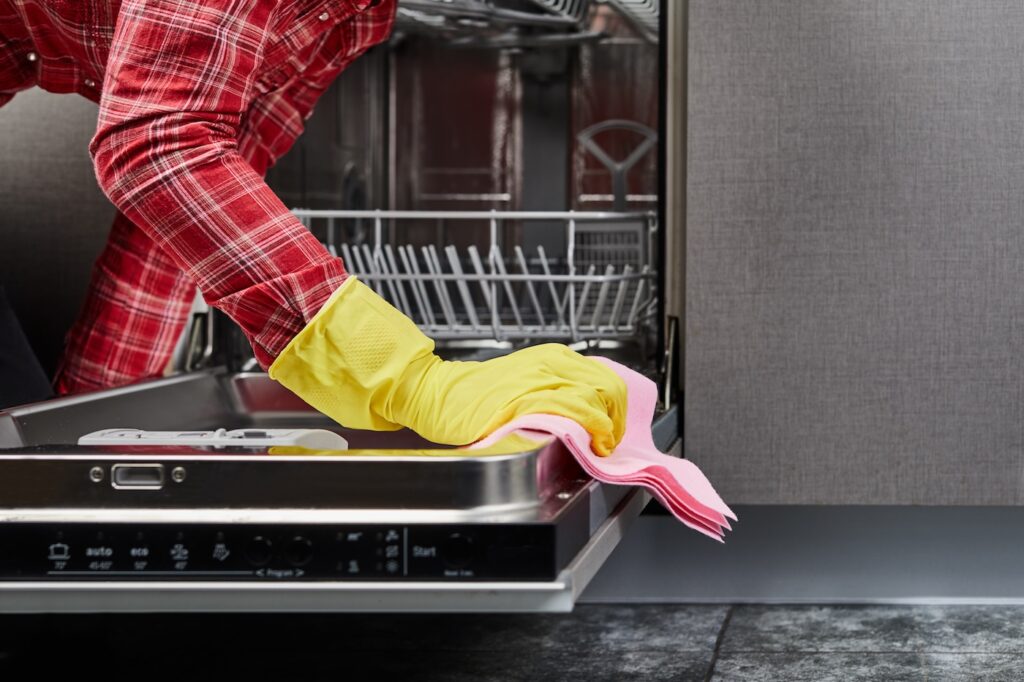Mold in bathroom ceilings is a common problem that many homeowners face. The warm, humid environment of bathrooms creates the perfect breeding ground for mold spores to thrive. Left unchecked, black mold and mildew can spread rapidly, causing unsightly stains and potential health issues.
Fortunately, removing mold from your bathroom ceiling can be straightforward with the right products and techniques. Read on to learn about the causes, consequences, prevention, and removal of bathroom ceiling mold.
What Causes Mold?
Mold can grow on the bathroom ceiling for several reasons, primarily due to the warm, humid environment that bathrooms provide.
The leading causes of mold growth on bathroom ceilings are:
- Excess moisture: Bathrooms produce moisture from sinks, showers, and baths. Without proper ventilation, it condenses on surfaces, promoting mold growth.
- Poor ventilation: Inadequate airflow traps humidity, causing condensation on ceilings.
- Warm temperature: Mold thrives in the warm environment of bathrooms and is exacerbated by showers and baths.
- Leaks: Pipe, window, or roof leaks add moisture, creating damp conditions for mold.
- Lack of sunlight: Limited natural light slows drying, allowing moisture to linger and mold to develop.
Addressing these causes by improving ventilation, fixing leaks, and maintaining a consistent cleaning routine can help prevent mold growth on your bathroom ceiling.
Tools to Remove Mold
To get rid of mold and effectively kill mold on your bathroom ceiling, you’ll need to gather the following tools and materials:
- Gloves (rubber or nitrile)
- Protective eyewear
- Sponge or soft-bristled brush
- Spray bottle
- Cleaning solution (white vinegar, hydrogen peroxide, or a DIY mixture)
- Warm water
- Microfiber cloths or rags
- Stepladder
- Plastic sheeting or drop cloths
The right tools and cleaning solutions are required to tackle the mold problem safely and efficiently. Gloves and eyewear will protect you from direct contact with mold spores and harsh chemicals. A spray bottle allows you to apply the cleaning solution evenly over the affected area, while a sponge or soft-bristled brush helps scrub away stubborn mold growth.
Warm water and a microfiber cloth are handy for rinsing and wiping down the treated surfaces after the initial cleaning. If the mold has spread across a larger area or onto drywall, plastic sheeting can help contain the spores and prevent them from dispersing further.
With the proper tools and materials, you’ll be well-equipped to tackle the mold problem on your bathroom ceiling like a pro.
Identifying Types of Mold

Identifying the specific type of mold present is crucial when addressing a mold issue in your bathroom. Different mold species can pose varying health risks and may require different treatment approaches. Understanding the characteristics of the mold you’re dealing with can help you take appropriate precautions and choose the most effective removal methods.
Here are some of the main types of mold you may encounter, along with their scientific names, identifying colors, and brief descriptions:
- Alternaria (Alternaria spp.): Black to olive-black or grayish, spreads rapidly, with suede-like or fluffy texture. Often found in bathrooms. Can cause life-threatening asthma, allergic rhinitis (hay fever), allergic sinusitis, and fungal balls in sinuses.
- Aspergillus (Aspergillus spp.): Dark green with a white border, aging to gray. Downy to powdery texture. Favors warm, damp areas like bathrooms. May cause allergic reactions, chronic lung conditions, and invasive disease.
- Chaetomium (Chaetomium spp.): Initially cotton-like in appearance but changes to bluish-green over time. Found on wood, drywall, and wallpaper in bathrooms. Prolonged exposure can worsen respiratory issues, especially in those with asthma or cystic fibrosis.
- Fusarium (Fusarium spp.): Pale to bright, ranging from white to yellow, pink, red, or purple, with a cottony texture. Found in damp areas, especially water-damaged surfaces in bathrooms. Can cause keratitis, onychomycosis, and more serious infections.
- Mucor (Mucor spp.): Rapidly growing, cottony to fluffy, white to yellow, turning dark gray. Found in damp areas like bathrooms, behind wallpaper, and under sinks. Known as black fungus, it can cause rare and deadly infections.
- Penicillium (Penicillium spp.): Fast-growing and can be white or green. Often found in damp or water-damaged areas, including bathrooms. Can cause allergic reactions, asthma, and, in some cases, infections.
- Stachybotrys (Stachybotrys chartarum): Slimy green or black mold, often referred to as “black mold.” Dangerous and commonly found in dark, humid areas like shower stalls and basements. Can cause nasal irritation, congestion, cough, wheezing, chest tightness, and dyspnea.
Identifying the type of mold can be challenging, and in some cases, professional testing may be necessary, especially if you suspect the presence of highly toxic molds like Stachybotrys. Regardless of the type, it’s essential to address mold growth promptly to prevent further spread and potential health risks.
Mold Health Risks

Harmful mold on bathroom ceilings can pose serious health risks if not addressed properly. Exposure to mold spores can lead to allergic reactions, asthma attacks, respiratory infections, and other serious health issues. If you suspect the presence of dangerous mold, it’s crucial to hire professionals. (For more on allergy-proofing your home, click here.)
To prevent mold from forming or returning, consider hiring deep cleaning services on Taskrabbit. Taskrabbit is a platform that connects you with trustworthy Taskers who can thoroughly clean your bathroom, including mold-prone areas like the shower and bathroom ceiling.
Taskers’ comprehensive cleaning can help eliminate mold spores and keep bathrooms pristine, stopping mold before it starts or preventing it from recurring. By using Taskrabbit’s cleaning services regularly, you can maintain a mold-free, healthy bathroom environment long-term.
Household Substances to Remove Bathroom Ceiling Mold

While professional mold remediation services are recommended for large or persistent mold problems, you may tackle small areas of bathroom ceiling mold yourself using common household substances.
Many natural and readily available items have antifungal and antimicrobial properties that can help kill mold spores and remove surface mold growth. Before reaching for harsh chemicals, consider these best mold removers for bathroom ceilings made from pantry staples:
- Vinegar: White distilled vinegar is an effective mold killer. How to use vinegar to kill mold: Spray undiluted vinegar directly on the moldy areas, let it sit for 15 minutes, then scrub mold off. Give the area a light vinegar spray, and allow it to air dry.
- Baking soda: Baking soda can help remove mold by absorbing moisture and scrubbing away spores. Mix baking soda with warm water, spray on mold, and scrub.
- Hydrogen peroxide: A 3% hydrogen peroxide solution can kill mold. Spray it on the affected area, but test first to ensure it doesn’t cause discoloration.
- Tea tree oil: This essential oil has antifungal properties. Mix a teaspoon of tea tree oil with a cup of water, spray on mold, let it dry an hour, then wipe clean.
- Lemon juice: Lemons’ high acidity can kill mold spores. Spray lemon juice on the moldy area, let it sit for 10-15 minutes, then wipe away.
How to Remove Mold on Bathroom Ceiling
Properly cleaning mold off the bathroom ceiling, bathroom walls, or shower curtain requires careful preparation and the right techniques. Here are the steps to effectively remove mold growth and prevent future issues:
1. Get Your Gear

Before starting, gather the necessary protective gear, such as rubber gloves, goggles, and a respirator or mask to avoid inhaling mold spores. Also, have a scrub brush, cleaning cloths, and a plastic sheet or drop cloth to cover surfaces and contain the mold.
2. Prepare the Cleaning Solution

Mix a solution of one part bleach and three parts water in a bucket or spray bottle. Alternatively, you can use a borax solution or undiluted white vinegar—effective natural mold removers.
3. Apply the Solution

Generously apply the cleaning solution to the affected area, ensuring it saturates the mold growth. Allow it to sit for 10-15 minutes to penetrate and kill the mold spores.
4. Scrub and Wipe

Using the scrub brush, vigorously scrub the moldy areas to remove as much growth as possible. Wipe away any remaining residue with clean cloths or paper towels.
5. Rinse and Dry

Thoroughly rinse the area with clean water to remove any remaining cleaning solution or mold particles. Use fans or dehumidifiers to ensure the area dries completely, as moisture can lead to mold regrowth.
6. Treat and Prevent

Once dry, apply a borate-based solution or mold-resistant primer to prevent future mold growth. Fix any moisture issues, such as leaks or poor ventilation, to stop mold from returning.
It’s important to note that if the mold growth covers an area larger than 10 square feet, it’s best to seek professional mold remediation services, as extensive mold infestations can pose health risks and may require specialized equipment and techniques for safe and effective removal.
Want to know more? Read about these important cleaning scenarios you might not have considered.
How to Prevent Mold in Your Bathroom Ceiling
Preventing mold growth in your bathroom ceiling is important to maintaining a healthy living environment and avoiding costly repairs. By controlling moisture levels and improving ventilation, you can significantly reduce the risk of mold infestation.
1. Control Humidity Levels

Start by using your bathroom fan during and after showers or baths to remove excess humidity. Open windows or install a circulating fan to promote air circulation and prevent moisture buildup. Regularly clean and dry the shower stall, towels, and bath rugs to eliminate potential breeding grounds for mold spores.
2. Invest in Dehumidifiers and Mold-Resistant Materials

If you live in an area with high humidity or have a windowless bathroom, consider investing in a dehumidifier to regulate moisture levels effectively. Applying anti-mold paint or installing ceiling cladding can create a barrier against mold growth on porous surfaces like drywall or plaster.
3. Address Underlying Issues

Despite your best efforts, mold may persist or recur, especially with underlying issues such as water leaks or poor ventilation. If you find yourself struggling with a persistent mold problem, it’s advisable to seek professional assistance.
How to Prevent Mole in Your Bathroom Ceiling
To prevent mold growth in your bathroom, regular deep cleaning is essential. Deep cleaning services on Taskrabbit provide a convenient solution by connecting you with experienced Taskers.
Taskers provide a deeper clean by disinfecting every corner of your bathroom, eliminating mold spores, dirt, and grime that could lead to infestations. Consistent deep cleaning through Taskrabbit can help you maintain a pristine, mold-free bathroom environment, contributing to a healthier living space for you and your family. Don’t let mold take hold—partner with Taskrabbit deep cleaning services for a consistently clean, mold-free sanctuary.














